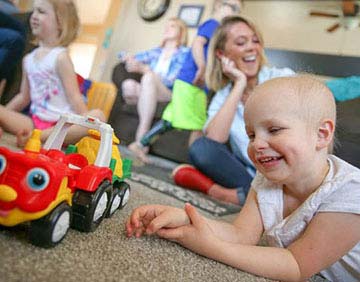Early assessment for children with disabilities can be enormously beneficial.
Shamby Polychronis is passionate about social justice and, in particular, inclusiveness for children with disabilities. Dr. Polychronis is a clinical instructor in the Special Education Department of the College of Education. Passion is hardly an unusual quality in university professors, but Polychronis has a personal connection: her son was diagnosed with a developmental delay at age two.

Sondra Stegenga and Shamby Polychronis
This personal connection catalyzed an already-existing passion for teaching into a career that focuses on social justice. In addition to children, Polychronis works with educators and parents on how best to include children with disabilities into the mainstream educational system. She says, "People sometimes see disability as a brokenness or something needing to be fixed." Polychronis prefers to see disability as another aspect of diversity — something to be embraced.
She says if people with disabilities were formally recognized as a minority group, "they would comprise the largest minority group in the United States. According to the Institute on Disability, nearly one in five people experience a disability of some kind.
Of course, there are many types of disabilities and the severity differs from one individual to the next. Nearly all persons with disabilities, however, share something in common — the desire to live meaningful and productive lives.

According to Polychronis and Sondra Stegenga, an assistant professor in the Department of Special Education, whose research focuses heavily on improving early intervention for infants and toddlers, ensuring that children with disabilities grow up in inclusive environments is critical for successfully integrating these children into society and enabling them to reach their full potential.
From infancy through adolescence, brain architecture undergoes important stages of development that form the foundation for a person’s future well-being. "Learning begins at birth, if not sooner,” Dr. Stegenga says. Recent research by the Harvard University Center on the Developing Child indicates that between birth and the age of three, children make a staggering 1 million new neural connections per second. With this in mind, early assessment for infants and children with disabilities can be of enormous benefit.

Successfully navigating the developmental stages from early childhood through adolescence is difficult under the best circumstances, but it can be especially challenging for individuals with disabilities and their families. Isolating children from their peers and placing them into separate, segregated programs can stigmatize children and needlessly limit the important experiences of childhood.
A better approach, according to Stegenga and Polychronis, is to include all children in mainstream preschool and school environments, while concentrating on the potential and diverse abilities of each child. This inclusive approach, when done right, can help ensure that challenges associated with disabilities are not compounded by segregation and exclusion.
Stegenga says resources exist for parents of children with disabilities — many of them free or low-cost. She encourages any parent with a child suspected of having a disability to obtain an early expert assessment.
Visit the Utah Department of Health’s Baby Watch early intervention program website for more information. Also visit the College of Education’s Department of Special Education information on programs leading to licensure.

